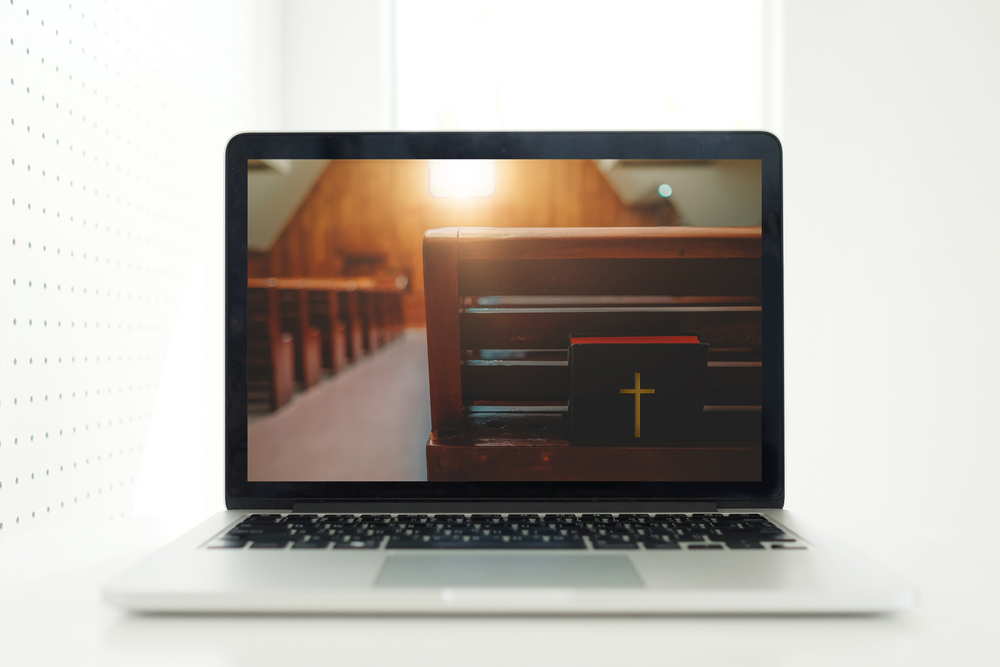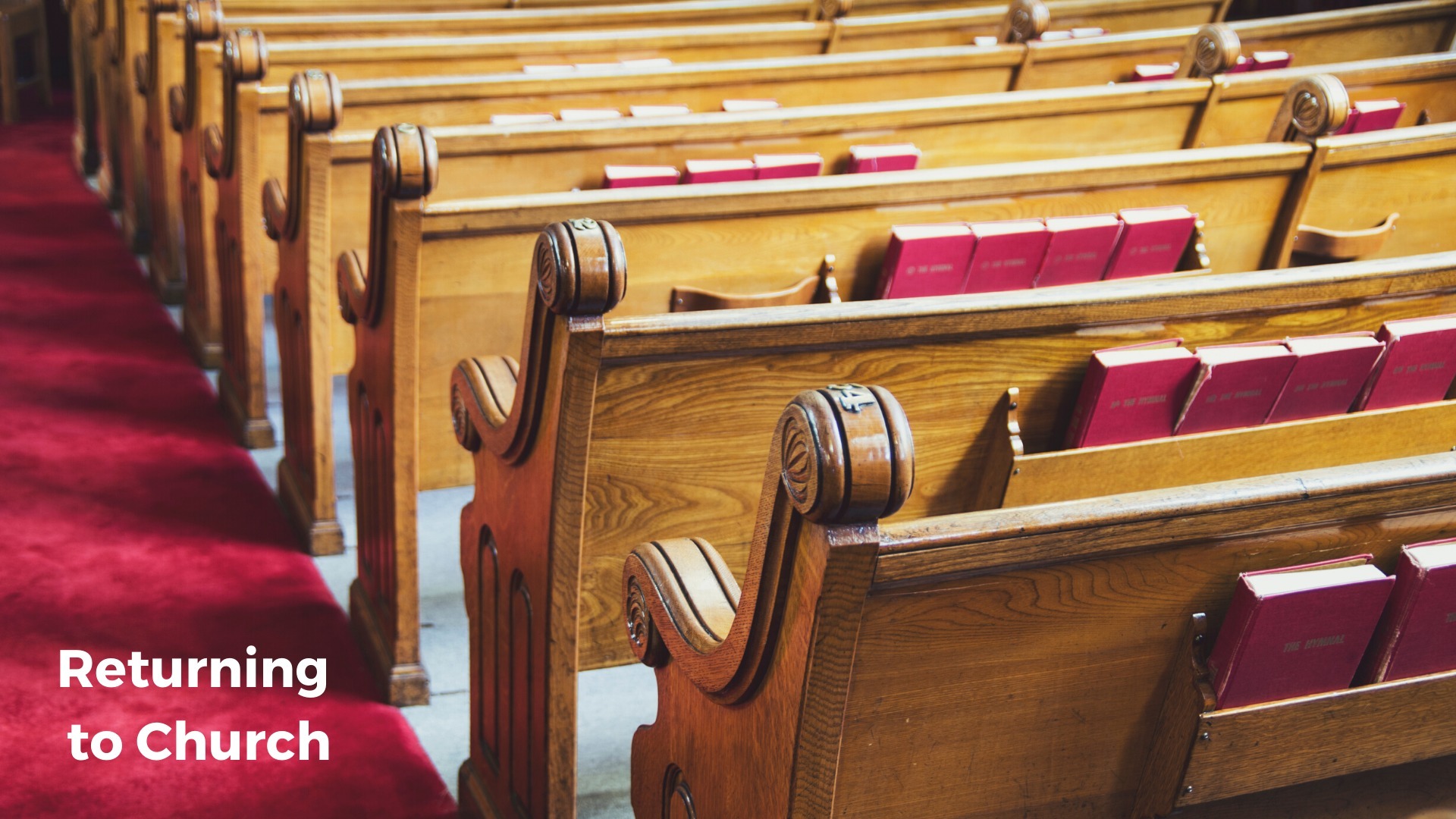Guidelines for returning to in-person worship
Download or view a PDF version of this article here.

When are we going to be able to worship together again? That’s a question weighing heavily on the minds of both clergy and church members—and unfortunately, there’s no simple answer. Given the current state and federal health agency recommendations, the number of cases of COVID-19, and the severity of the illness for a portion of the population, it’s clear we’re not going to be able to simply resume the types of gatherings we had in February.
The question we need to shift our attention to asking isn’t about when to re-open our churches and resume gathering but how to do it. What have we learned from our virtual or online worshipping experiences that we want to lift up and bring forward? In order to keep people healthy and safe, recovering from the pandemic is going to need to be a marathon, not a sprint. In other words, returning to church will be different and will need to happen in phases. The North Dakota and South Dakota Departments of Health have said that restrictions will be lifted in communities gradually, so initially small groups of 10 or fewer will be able to safely gather. Over time, that number will increase in the reverse of how it decreased—so 10 perhaps becomes 50, then 100, then 250, as the situation in your community is sustained or improves.
“As I have said before, I believe those of us in the faith community should be the first responders when it comes to the spiritual, physical, and mental health of all of God’s people,” said Bishop Bruce R. Ough. “Therefore, I am asking every congregation to continue to suspend in-person worship, until you carefully and prayerfully develop a plan for how to return to a new form of in-person worship in a gradual manner. Most congregations would be wise to spend the entire month of May putting a plan in place, especially those in communities that are experiencing a high number of cases of COVID-19 or have not reached a peak in the number of cases. It is advised to strictly adhere to federal, state and local recommendations. As we continue to navigate this challenging season, let us remember that God is with us.”
Creating a plan for your church

Although it is imperative that we continue to take our cues from the North and South Dakota Governors' Offices, the North Dakota and South Dakota Departments of Health, and the Centers for Disease Control and Prevention, spend time working with your leadership team to consider how you might safely offer small group in-person worship experiences, blended with virtual opportunities, as state and local guidelines allow it. Create a written plan that addresses the following questions:
- How can you include plans to continue and even enhance your on-line presence, especially for those who engaged with your worshipping community for the first time online and those in vulnerable populations?
- What would it look like to offer multiple small group, some virtual worship and some in-person worship experiences rather than one large gathering?
- Where could smaller in-person gatherings be held and how will you ensure social distancing of at least six feet between each family unit? Who could help lead smaller in-person and virtual gatherings? If you have a large church, it might not be feasible for your pastor(s) to lead each one. What times could these gatherings be offered to enable broad participation? If you’re meeting in the sanctuary, consider having one family unit per pew and cordoning off every other pew to allow for proper distancing. If you have a smaller sanctuary, consider meeting outdoors.
- How will you thoroughly clean and disinfect surfaces between each gathering? Be sure to sanitize every surface, especially hard surfaces, in common areas before and after each group meets.
- How will you handle greetings and passing the peace without person-to-person contact? Use no-touch alternatives like a friendly wave, a slight bow of the head, or crossing your arms over your heart.
- How you will collect the offering without person-to-person contact? Consider having one or more baskets around the sanctuary that people could simply place their offering into during worship.
- How can you minimize the number of items that need to be touched or distributed, and ensure anything that requires a direct touch point is done in a safe manner? Consider using screens or bulletins (one-time use only) rather than Bibles, hymnals, or other worship books to avoid having multiple people touch surfaces that could carry the virus.
- How will you offer communion in a safe manner? Consider alternatives for communion—like offering it online only, as touching or removing face masks contaminates them. If you do in-person communion, have each person pick up a set of pre-packaged elements as they enter and remain socially distanced in their seats as they take communion.
- How could you provide music safely? As difficult as this is to think about, consider not singing when gathered. Singing has been known to spread droplets/aerosols that carry the virus a substantial distance and keep them suspended in the air, and a cloth mask is unlikely to be adequate protection. Instead, consider playing pre-recorded songs and asking those gathered simply to listen.
- How will you handle fellowship time? Consider creating opportunities for fellowship time online instead of before or after worship. For everyone’s safety, think about encouraging people to leave the building as soon as worship concludes.
- Which other precautions will you take? Consider having each person wear a cloth face mask in accordance with health agency recommendations for those gathered in public spaces. Your church could make and offer these to those who don’t have one. Verbally and with signs posted on entries, tell people what the symptoms of coronavirus are—and advise those who aren’t feeling well or are exhibiting any symptoms to stay home. Also consider not providing volunteer nursery care when you first begin in-person gatherings given that social distancing guidelines likely couldn’t be followed in a nursery with small children.
- How will you make the gradual transition to larger in-person gatherings? We urge you to expand the number of people gathered in accordance with North Dakota and South Dakota Department of Health guidelines and increase the number gradually. Even when it’s safe for small groups to gather, encourage those over 60 and with underlying health conditions to continue to connect virtually until health agencies indicate it is safe for them to participate in-person.
- How will you continue to offer online options for those who cannot or do not feel comfortable meeting in-person?
- How will you direct the flow of traffic in your church to ensure everyone’s safety? Consider having people enter through one door and exit through another door, one family unit at a time, so as to avoid unintentionally disrupting social distancing guidelines—and think about propping open the entry and exit doors to eliminate the need for people to touch door handles.

Other recommendations
We offer considerations for other ways you can keep your congregation safe now and as we head into the summer:
- If a family decides to have a funeral service immediately, limit attendees to the same number gathering for worship at that time; encourage families to have funeral services outdoors so people can more easily adhere to social distancing guidelines. Live stream funerals whenever possible to allow greater participation.
- We strongly advise against having in-person Vacation Bible School (VBS) as children can be asymptomatic carriers of the virus. Instead of VBS, consider offering a virtual gathering for children that includes some type of lesson and activity and/or providing backyard VBS kits for families to use at home.
- We strongly recommend against offering mission trips this summer as travel will be risky for some time. Rather than going on a mission trip, partner with your local food shelf or emergency shelter, and help it meet vital needs.
If you have questions as you develop your plan, please feel free to contact your district superintendent.
Additional resources:

North Dakota Smart Restart
South Dakota’s Back to Normal Plan
Guidelines for Opening Up America Again
Guidelines for Faith-Based Communities, Minnesota Department of Health
Returning to Church, Wisconsin Council of Churches24 Questions Your Church Should Answer
Before People Return, Ken Braddy Jr,
Avoid This Big Mistake: Stepping Back Into the Past When You Step Back Into Your Building, Carey Nieuwhof
Church in These VUCA Times, Jake Morrill
Finding Our New Normal, Susan Beaumont,Congregational Consulting GroupLeaders
It’s Time to Ask Critical Questions About Post-COVID-19 Church, John Thornburg, United Methodist Insight
Distributed Church, Fresh Expressions

